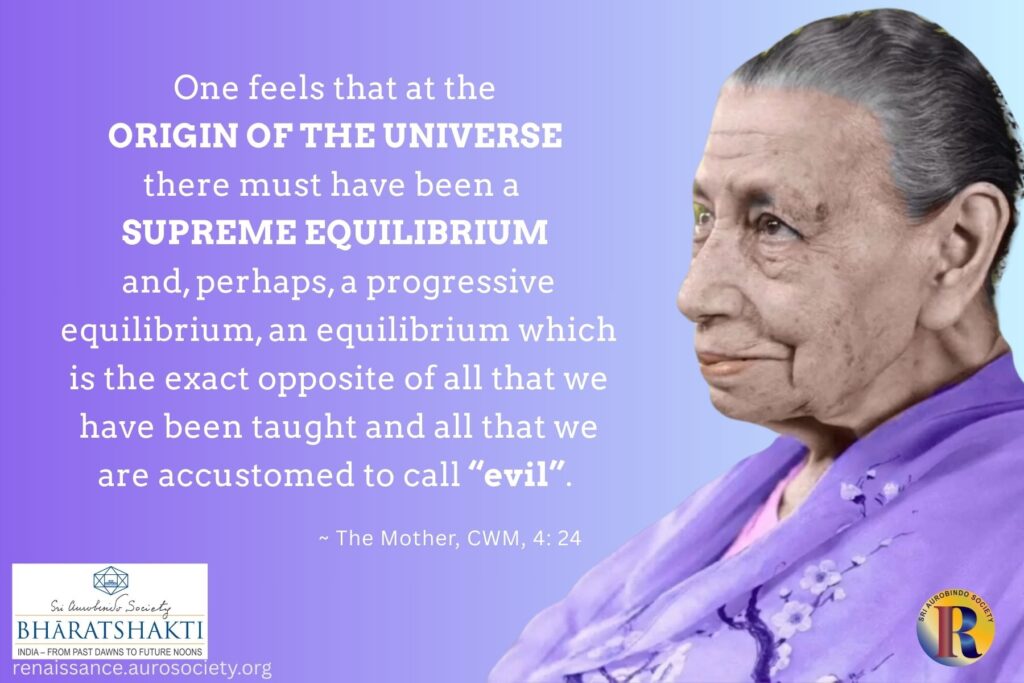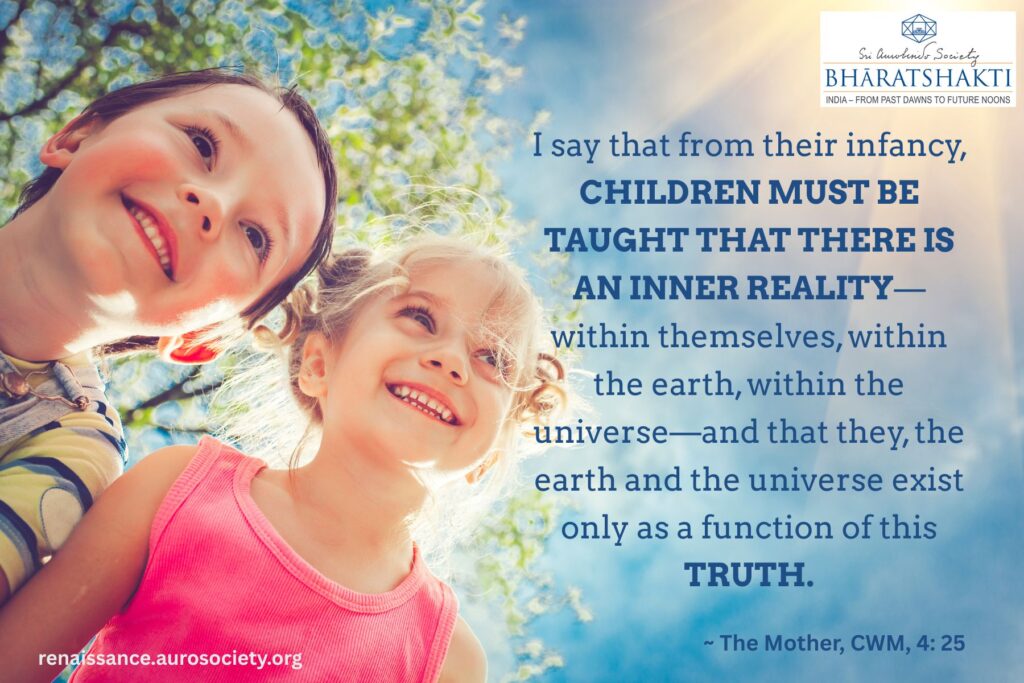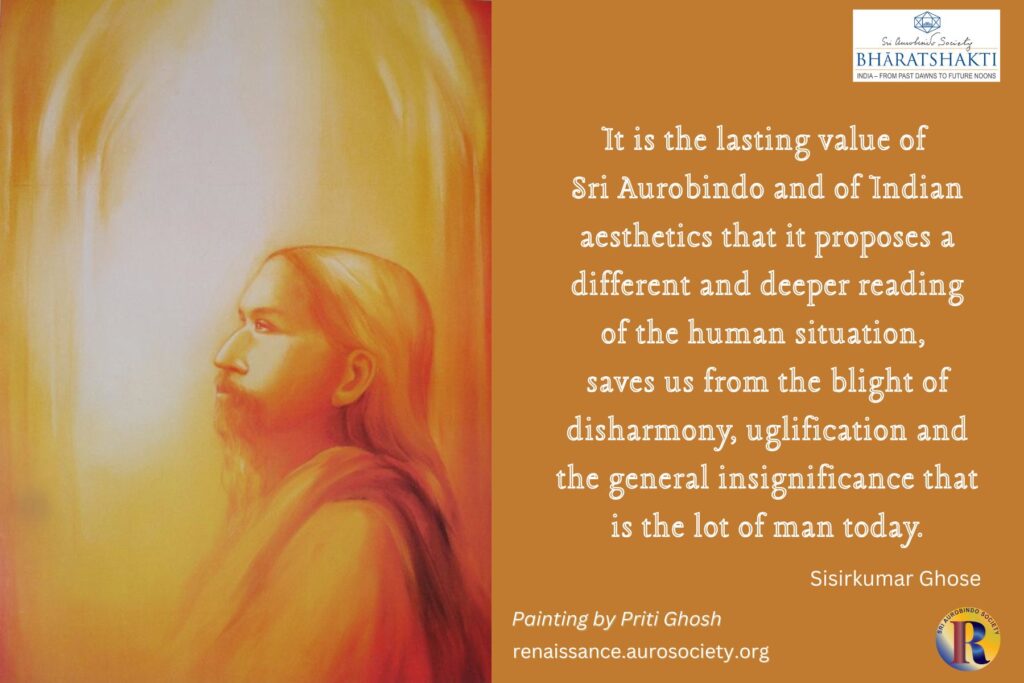Editor’s note: The author ingeniously connects the three paths of Yoga – Action, Love and Knowledge – with some of the most important works in world literature that speak of the highest seeking of the spirit. He reminds that “if there is a highest point of meeting between Literature and Yoga, it has to be in the works of Sri Aurobindo.”

If we take the central emphasis of Sankara’s Mayavada or Buddha’s teachings on suffering, the impression that we get is: This life is imperfect; this life is nothing but delusion (moha) or dukkha. Real happiness is elsewhere – whether in the merger with Brahman or in the extinction of the ego in Nirvana. In spite of the lofty ideal that is put forward before us of Brahman or Nirvana, the essential idea that leaves its imprint on our minds is, “not this life, but elsewhere; not life on earth but the ultimate felicity is to be found in some other-worldly plane of Brahman or Nirvana.”
Yoga – Sadhana in Life on Earth
But the approach of Yoga is different. For Yoga, life on earth is an opportunity for doing sadhana. For Yoga, life on earth is not a cursed life. But a school where the spirit of Man struggles against all odds and comes out glorious in the victory of the Spirit over Matter. Or to take the approach of the Gita, life is a Kurukshetra, a battle field where the human Soul has to fight for its redemption.
Thus for the Yogin, life is a school, a battlefield or a laboratory where he performs his experiments with the various instruments of his being – body, emotions and intellect to discover the higher planes of consciousness and to achieve the final union with the Divine. For the word Yoga is derived from the Sanskrit yuj, meaning to join, to unite.
This is the approach of Yoga. Not an escape, but a fight. Not to devalue but to divinise. For the world is enveloped by the Lord says the Isha Upanishad. Yoga is the Sadhana that is required to be performed in life on earth itself and not in some celestial plane.
See our Flipbook on
Isha Upanishad with Sri Aurobindo’s Translation
Over the centuries, numerous Yogins and Sadhaks have left us the records of their inner journeys, their experiences of the higher planes. They have expressed what they had experienced – to whatever extent it is possible to express using the human language – of those rarefied heights and have conveyed to us their inspirations, visions and glimpses of those higher states of consciousness.
Though the expression in language can never convey the immediate experience which is too private and intimate – but for seekers like us they can act as invaluable sign posts on our own journey to the extent we have acquired the adhikāra to receive such knowledge. Sri Aurobindo himself made the point when he said:
Even when Supermind finds expression it would carry its meaning only to the man who knows; as the Veda puts it, “Words of the Seer which reveal their mystery only to the Seer.” One can’t express the Supramental Truth but something of it can come through.
~ Evening Talks with Sri Aurobindo, recorded by A. B. Purani, 12-10-1926
This is how life, Yoga and literature are related. It must be emphasised that here we are not talking about ordinary literature but about spiritual or mystical literature which is a record of spiritual experience.
The study of human nature reveals that there are three great motive forces in human life: will, emotions and the intellect. These are the three forces that impel us to move, impel us to do anything. The three corresponding modes of expression of these forces are through the body, heart and the head. Accordingly, three paths of Yoga have emerged based on these three motive forces. The path of Action (Karma Yoga), the path of Devotion (Bhakti Yoga) and the path of Knowledge (Jnana Yoga).
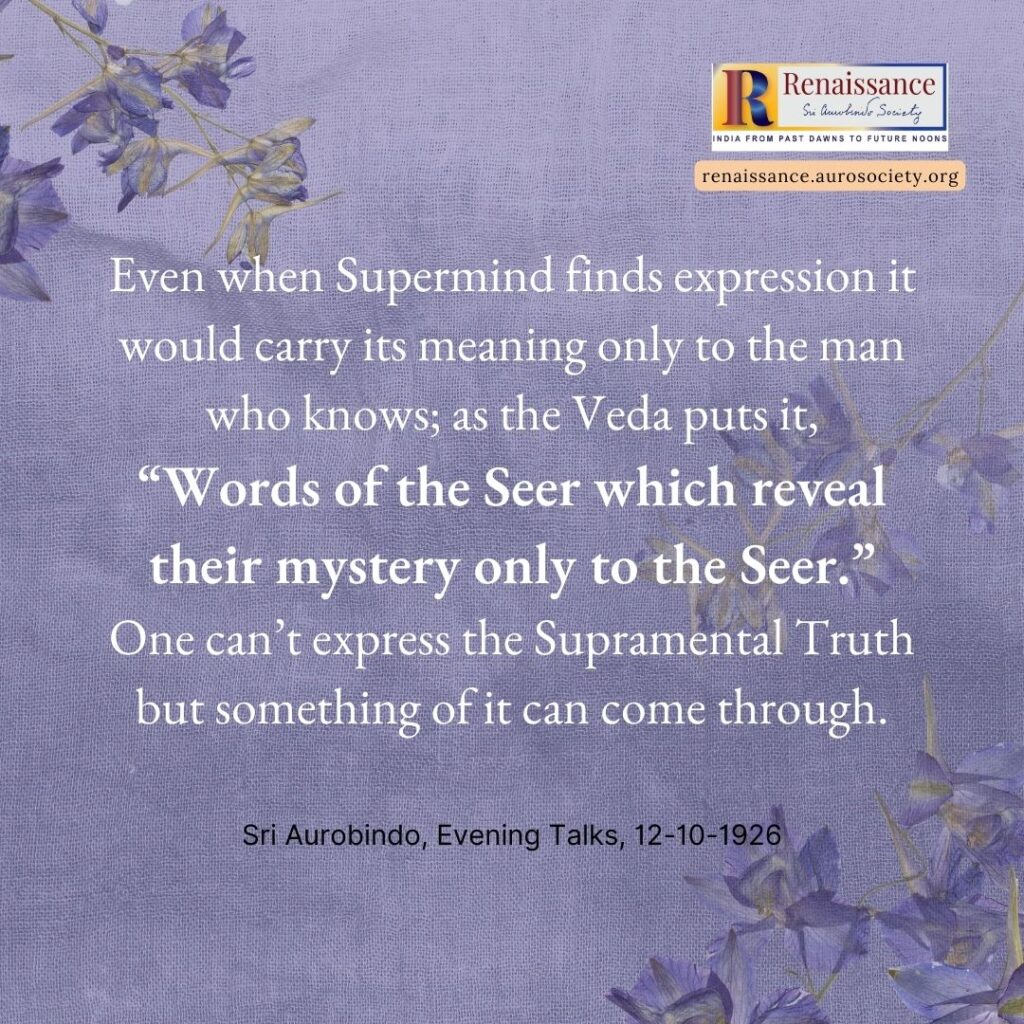
The Path of Action in Literature
In the Western spiritual tradition, this quest has often taken the form of a craving which makes the seeker a pilgrim, a traveller, a wanderer in search of a fabled land, a land of joy and peace. So, the spiritual seeker goes on a journey, undertakes hardships, faces challenges and finally reaches his destination – a blessed place of Grace and peace.
In spiritual literature, the most well-known expression is be found in Dante’s Divine Comedy where the poet undertakes an arduous, difficult journey through the multiple, labyrinthine circles of Hell (Inferno) to emerge on the foothill of the mountain of Purgatory, and thereafter he climbs the mountain and higher into the clouds thereby reaching Paradise to gain the beatific vision of God.
Another expression of the same kind of travel, search and pilgrimage can be found in John Bunyan’s The Pilgrim’s Progress where Christian, the traveller, makes the arduous journey from the City of Destruction to the Celestial City. The whole story is rich in allegory and symbolism where Christian is shown carrying a heavy burden on his back (the burden of his sins) as he makes progress towards his goal, the Celestial City.
He encounters various situations and locations such as the Slough of Despondency, the Hill of Difficulty, the Valley of Humiliation, a town called Vanity and he also encounters several characters along the way who either create problems for him or come to aid him. The various characters he meets on the way are Evangelist, Help, Sloth, Mistrust, Charity, Discretion, Envy, Watchful etc. Facing the different trials and challenges, Christian finally reaches the Celestial City.
Again, in Sufi literature, we come across Farid-ud-din Attar’s magnificent allegorical poem The Conference of the Birds where a group of birds set out in search of a mythical king of the birds for which they have to cross seven valleys. The valleys are significantly named as the Valley of the Quest, Valley of Love, Valley of Bewilderment, Valley of Knowledge and so on, which are nothing but progressive stages in the spiritual quest.
Coming to the spiritual tradition of India, we find one of the most potent expressions of the path of Action in the magnificent teaching of Karma Yoga in the Bhagavad Gita.
The setting is the battlefield of Kurukshetra where the Divine teacher Krishna imparts the teaching of Karma Yoga to his disciple Arjuna who is paralyzed by the enormity of the challenge facing him. A way of life is given out for the warrior Arjuna which has to be practiced in every moment of life. The uniqueness of the Gita lies in the fact that work in the world itself has been given as a spiritual practice.
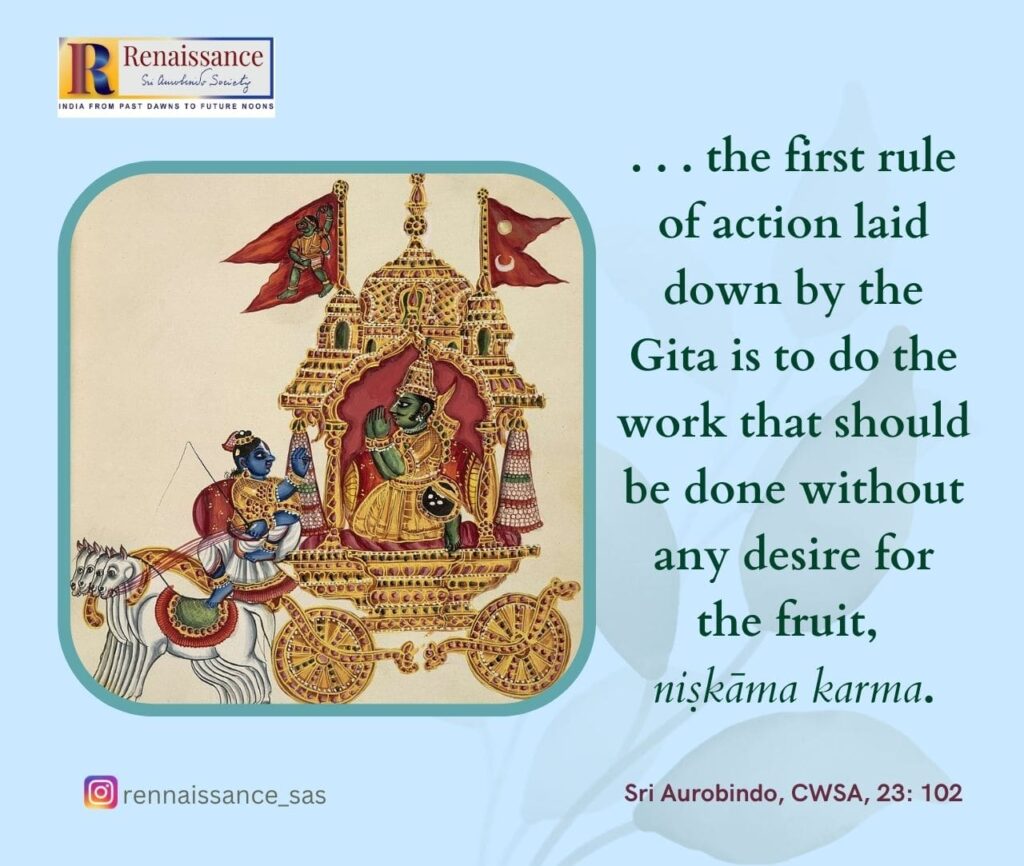
The Path of Devotion in Literature
“One single moment of the madness of extreme love of God brings us eternal freedom,” declared Swami Vivekananda.
The path of Love is one where God is the Beloved and the yearning soul is the lover. If we do not have a first-hand experience of this kind of love, the next best thing for us is to sit on the shore of this vast ocean of love where the great lovers of God have drowned themselves and left behind some exquisite poetry to record their emotions.
Such love poetry is an expression of an all-consuming love where the lover completely annihilates his own individuality in the intoxication of Divine Love. In Sufi poetry, the imagery that has been used is of a moth that burns itself in the flame to become one with the flame. Rumi says:
Fly straight into the candle, this burning so dear
No coolness can tempt us out of its flame……
The first objection that comes from our rational mind is, how can we become so detached from worldly things that we are willing to burn in this all-consuming love? Here Swami Vivekananda gives us an extremely valuable lesson: “Bhakti Yoga does not say ‘Give up.’ It only says, ‘Love – love the Highest!’ And everything low naturally falls off from him, the object of whose love is the Highest.” Rumi expresses this indifference to worldly things in exquisite poetry:
Come to the orchard in Spring.
There is light and wine, and sweethearts
In the pomegranate flowers.
If you do not come, these do not matter.
If you do come, these do not matter.
Kabir of course, has given the essence of the path of Love with his declaration:
When I was, God was not;
Now only God is, and I am not.
Narrow is the path of Love;
Here two cannot go.
Now we may find all this talk of self-annihilation in this all-consuming Divine love extremely threatening to our existence. For us, it is almost like death. Or some kind of insanity, madness. Rumi agrees that it is madness. He says:
Let the lover be disgraceful, crazy, absentminded.
Someone sober will worry about things going badly.
Let the lover be.
Apart from Kabir, we find an ecstatic outpouring of divine love in the songs of Meera, Nanak, Surdas, Tukaram, Ramprasad and many such saints of the Bhakti movement.
It is usually put forward that the path of love is the easiest of the paths because emotions come to us naturally and most of us are emotional by nature. So making use of the emotions to reach the Divine is the easiest way. But going through these expressions of the “mad,” God-intoxicated lovers, you can judge for yourself whether you are capable of this kind of abandon and surrender to the Divine.
This is a far cry from our give-and-take and transactional kind of love. Can you be mad? Can you be intoxicated like this? Only then is the path of Love for you.
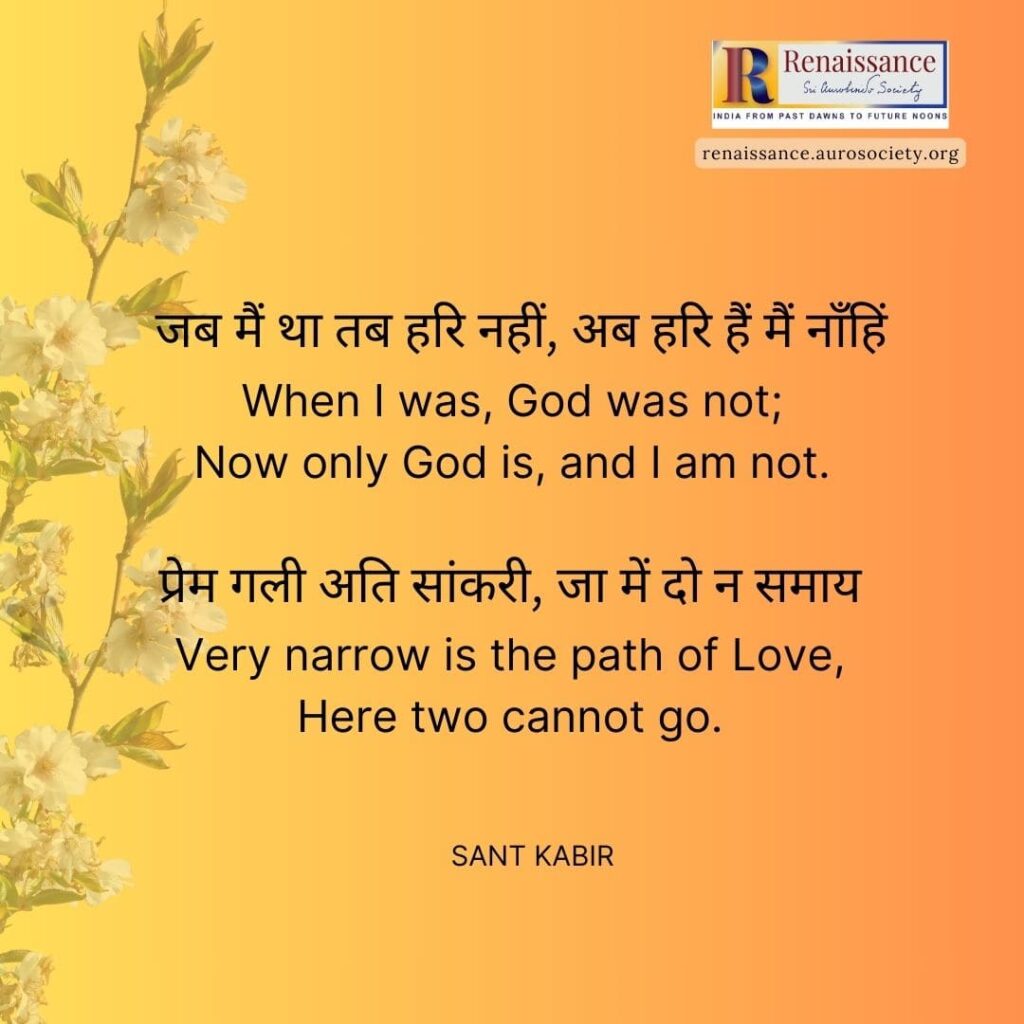
The Path of Knowledge in Literature
The path of Knowledge takes the route of the intellect but ultimately it strives to go beyond the intellect to realize the Truth which is a transcendental experience. The method to go forward is study and receiving guidance from an authentic guru who himself has realized that state of divine consciousness.
In Christian literature, the most profound expression is found in the Sermon of the Mount of Jesus. It contains the essence of spirituality. In the Epistles of St. Paul, we find the clearest statement of Christian faith and belief and the foundations of Christian theology. Thereafter in the works of St. Augustine like Confessions and The City of God we find a synthesis of the paths of Knowledge and Devotion.
Then in the Summa Theologica of St. Thomas Aquinas, we find a synthesis of the Aristotelian worldview with Christian theology. A brave attempt to understand the Divine though the head!
However, the greatest mystic and Yogi of the Western world is a lesser-known personality who went by the name of Plotinus. His Enneads is a mystical and spiritual classic and, in my opinion, the highest achievement of Western mysticism. If there is any Western figure who comes anywhere close to Sri Aurobindo, it has to be Plotinus. Sri Aurobindo said it as much when he declared,
Plotinus was not a mere philosopher, – his philosophy was founded on yogic experience and realization.
~ CWSA, Vol. 25, p. 522
In Buddhism, apart from Nagarjuna’s Madhyamaka Karika and the Lankavatara Sutra of the Yogacara school, we see the finest expression of the higher states of consciousness in the Prajnaparamita Sutras of Mahayana Buddhism. And in Hindu metaphysics, we have the Bhagavad Gita, Brahma Sutras and the Upanishads and the legendary Sankara Bhashyas on them. Then we have the Gospel of Sri Ramakrishna and Swami Vivekananda’s complete works in nine volumes.
And finally, we have the thirty-six volumes of the complete works of Sri Aurobindo.
It is a monumental achievement and an unsurpassed feat by any Master anywhere in the world – the final and ultimate destination for all who aspire to be Jnana Yogis. To bring down the higher states of consciousness into the language of the intellect and to take to mystical poetry wherever prose proved inadequate to the task, is a feat that only Sri Aurobindo could have performed.
We have to have some level of adhikāra to fully understand what he wrote and that is why it has been said that it requires tremendous brain power to understand the works of Sri Aurobindo.
Read 2-part article by the same author:
On Reading Sri Aurobindo: A Personal Account
Sri Aurobindo’s Literature
If there is a highest point of meeting between Literature and Yoga, it has to be in the works of Sri Aurobindo. Because that is where he recorded what he experienced in his Yogic Sadhana and left a huge body of work for the future generations of seekers.
Speaking about The Life Divine, he said during his Evening Talks: “The Life Divine is not philosophy but fact. It contains what I have realised and seen.” (12-10-1926). And he took to poetry, when prose could not capture what he had to convey. One is reminded of what Krishnaprem once wrote in a letter to Dilip Roy,
Poetic expression can sometimes deal with realms in which philosophy cannot breathe… our philosophic dialectic, logic etc., are far too coarse to deal with the higher levels of reality.
~ Sri Aurobindo came to me, p. 338
That is why Sri Aurobindo had to write Savitri. Book II and Book VII of Savitri, The Book of the Traveller of the Worlds and The Book of Yoga respectively, are a magnificent expression of the different planes of consciousness and the Yogic ascent.
Also read in this issue:
“To read Savitri is indeed to practise Yoga.”
We can never get to know what Sri Aurobindo did actually experience in his Yogic sadhana – the planes of the Overmind or Supermind. If we have to get any glimpses, any whiff of that supernal air – then we have to delve deep into the pages of Savitri.
Sri Aurobindo considered Savitri important enough to devote to it more than forty years of his life. In Savitri, literature touches the ethereal and rarefied air of the highest Himalayan peak of human experience. That is why the Mother herself said:
Savitri is a revelation, it is a meditation, it is a quest of the Infinite, the Eternal. To read Savitri is indeed to practice Yoga…
~ Mona Sarkar, Sweet Mother
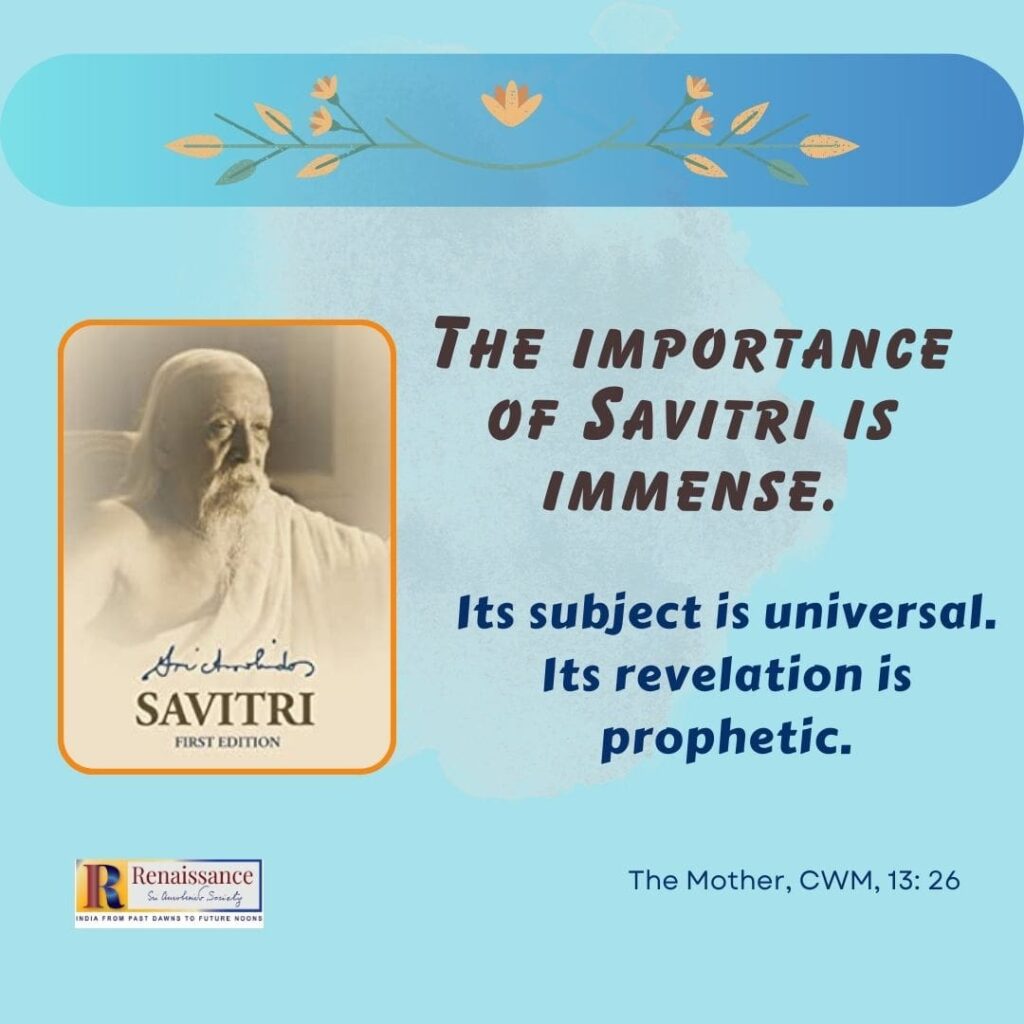
Since our theme is Life, Literature and Yoga, let us turn to Savitri and explore what Sri Aurobindo had to say about spiritual literature itself where we find him speaking about the Rishis who were the composers of the Upanishads:
Others escaped from the confines of thought
To where Mind motionless sleeps waiting Light’s birth
The Upanishadic Rishis who escaped from the confines of thought and in the passive stillness of the Mind waited for the higher Reality to reveal itself (Light’s birth)
And came back quivering with a nameless Force,
Drunk with a wine of lightning in their cells;
They returned to the earthly consciousness suffused with the Divine force and drunk with the wine of spiritual ecstasy which felt like lightning in their cells
Intuitive knowledge leaping into speech,
Seized, vibrant, kindling with the inspired word
Giving shape in human speech their intuitive knowledge, they uttered the inspired word – the Mantra
Hearing the subtle voice that clothes the heavens,
~ Savitri, Book IV, Canto IV, CWSA, Vol. 34, p. 383
Carrying the splendour that has lit the suns,
They sang Infinity’s names and deathless powers….
Hearing the voices of the higher planes, and carrying that Divine splendour that had the power to set suns afire, the Rishis caught in their inspired web of words, the Infinite and sang about powers that knew no death.
In the sublime poetry of Sri Aurobindo’s Savitri, Life, Literature and Yoga come together in a perfect union and become one.

About the author:
Narendra Murty is the author of two books Eating His Money: The Antics of a Metaphysical Clown and An Odyssey of the
Mind: Journeys: in the Modern Mindscape. Both the books are available on Amazon. His third book, The Religion of Wonder, will soon be published by AuroPublications, Pondicherry. He is presently working as a full-time volunteer for the Renaissance journal as well as AuroLeadership project at Sri Aurobindo Society, Pondicherry.

~ Design: Beloo Mehra

